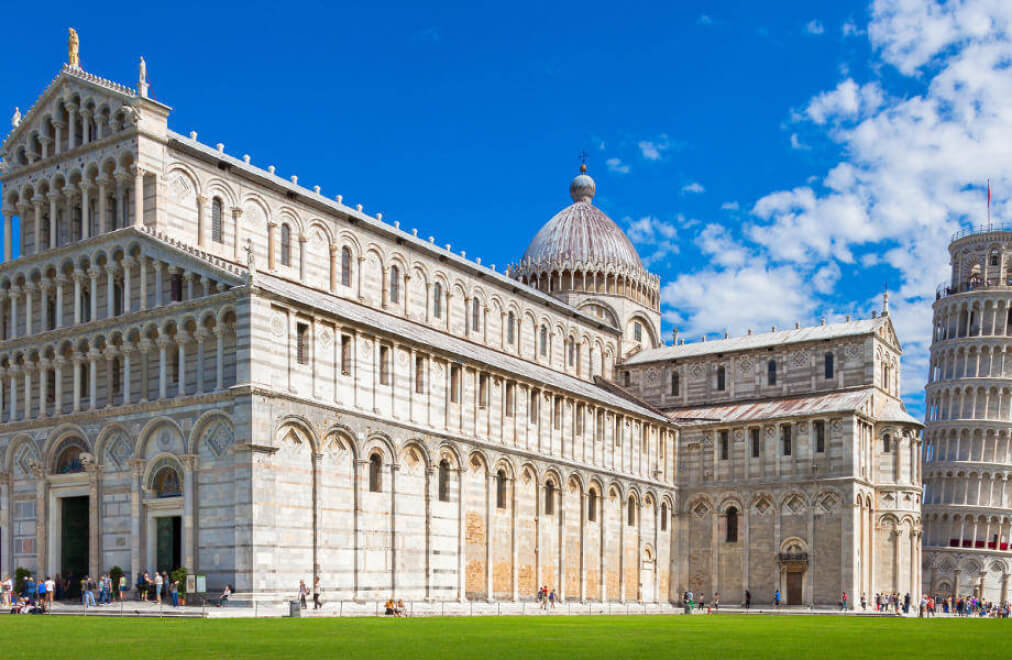
Assistance
Click to start searching

Pisa Cathedral
The Duomo Santa Maria Assunta, or Pisa Cathedral, was an almost revolutionary construction in the 12th century – a sight that even today is still spectacular. A five-nave Romanesque columned basilica with a three-nave transept and intersecting dome – there was nothing else like it in Italy at the time. The campanile (bell tower) may now have surpassed the Duomo in popularity due to its structural tilt, but no trip to Pisa would be complete without visiting the Cathedral. It is indeed quite miraculous how Pisa’s four major sights – the Cathedral, the Baptistery, the Leaning Tower and the Camposanto – can be found in one place, on the Piazza dei Miracoli!
Clad in precious Carrara marble, the Cathedral was long regarded as the most magnificent sacred building in the Western world. It also symbolised the powerful position of the former seafaring Republic of Pisa over other Tuscan cities such as Siena and Florence. The façade radiates calm and cohesion from afar, but the richness of the detail and varied hues of the marble are evident on closer inspection.
From the outside alone the Cathedral is monumental. It certainly did not fail to impress Pisa’s adversaries and gave inspiration to many imitators. The wonders of the Cathedral are not restricted to its exterior, however, despite the considerable damage caused by a fire in 1595. The large mosaic in the apse, created by the Florentine artist Cimabue, and the marble pulpit built by Giovanni Pisano are still impressive today.
The chandelier suspended from the wooden ceiling of the main nave is also known as the “Galileo chandelier”. There are still – unfounded – rumours that it was the inspiration for the Grand Master’s theory about the isochronism of the pendulum. With all this splendour, it is hardly surprising that the Duomo Santa Maria Assunta, together with the Leaning Tower, the Camposanto and the Baptistery, has been listed as a UNESCO World Heritage Site since 1987.
Pisa Baptistery
West of the Cathedral is the Baptistery, one of the world’s largest baptismal churches. The fact that, for very many years, baptisteries were built separately from the main places of worship, dates back to early Christian traditions. In Italy especially, this culture persisted for a very long time. But why the separation? At a time when adult baptisms were chiefly carried out in large numbers and only on certain days of the ecclesiastical year, a separate, spacious baptismal church was needed – also because, above all, unbaptised individuals would not have been permitted to enter the main church. With the introduction of baptism for children and the gradual loosening of the regulations, however, the baptisteries increasingly lost their purpose.
Just like Pisa Cathedral, the associated Baptistery can be regarded as a majestic demonstration of the power of the merchant and seafaring nation of Pisa. The major northern Italian cities of Florence and Genoa rose to national prominence only after the Genoese destroyed the Pisan fleet in 1284.
Today, few people are aware that the dome of the Baptistery was once shaped like an open cone. Only later additions turned it into the now semi-circular dome, closing the upper opening. In addition to the shape of the roof, the generous, bright interior and the extraordinary acoustics of the baptismal church are particularly impressive. Occasionally, the vergers strike up a small melody which, thanks to the echo, sounds like a mini organ recital.